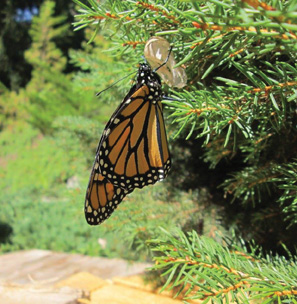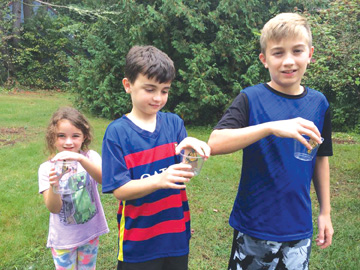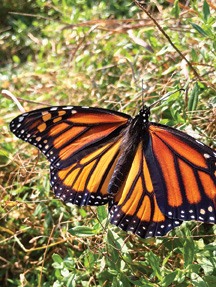
By Kristin DeJohn

Courtesy Lynn Dischler
“We used to see lots of monarch butterflies,” laments Bolton resident Rona Balco. As president of Friends of Oxbow National Wildlife Refuge, Balco has organized annual monarch butterfly walks to educate about their life cycle and annual migration to Mexico. However, in 2015 and 2016 no monarchs were found, and the walks were canceled.
This year, the walk returned. “We had a wonderful time,” says Balco. “We saw a little caterpillar and eggs and we captured one monarch.” Attendees of the walk, held at the refuge on Sept. 16, had a chance to view the butterfly up close before letting it fly away.
Over the last decade, the Eastern migratory population of monarch butterflies has declined by about 80 percent. Causes include increased pesticide and herbicide use in farming and residential lots, the loss of milkweed plants (food source), illegal logging in Mexico and changing weather patterns. Still, monarch watchers are encouraged by recent sightings.
“We had monarch caterpillars in our butterfly garden this year after two years of not seeing them, and have been seeing adults flying on a daily basis,” says Martha Gach, conservation coordinator at Mass Audubon’s Broad Meadow Brook Wildlife Sanctuary and Conservation Center in Worcester. “It has been a good year for these butterflies, but our New England monarchs depend on the winter habitat in Mexico,” she adds. “What happens there impacts the butterflies we see.”
Tracking Monarchs
The monarchs that become butterflies in the fall are the ones that undertake the journey to Mexico and back. Tagging programs, that attach tiny markers to the butterflies, allow researchers to track migrations.
“For the last two years, our fall tagging programs were lucky to find one butterfly,” says Kristin Steinmetz, education coordinator at Mass. Audubon’s Wachusett Meadow Wildlife Sanctuary in Princeton. “This year, our tagging programs are much more satisfying for participants, with four or five or more butterflies tagged in each program. This doesn’t rival the large number of monarchs we used to tag a decade or so ago, but it is encouraging.”
A variety of organizations in the U.S. and around the world are partnering to track, count and reverse the decline of monarchs. The Massachusetts Butterfly Club, a chapter of the North American Butterfly Association, creates a database of sightings, which is updated each winter. “There are a lot of variables in butterfly sightings,” says club past president Madeline Champagne. “But, for sure, in 2015 and 2016 the numbers were very low, especially with the drought, compared to this year and previous years.”
“If, in fact, it can be shown, as I suspect it will be, that this has been a good year for the monarch, it will still be much too early to conclude that they are out of the woods,” says Marj Rines, a naturalist at Mass Audubon. “There are so many variables that could affect populations.”
A Helping Hand
Due to loss of habitat and predation, experts encourage people to raise monarchs. “It is a ‘rescue’ operation, as survival rate in the wild is low,” says Champagne.
Bolton resident Stacia Downey recently delved into monarch rescue after noticing a lone milkweed with a few caterpillars on it. “We let it be, but the next day the plant was entirely eaten,” says Downey. “Some of the caterpillars were climbing up the side of the house and we noticed one had died in a spider web.”

Downey, who had helped her preschool class raise monarchs, stepped into action: “We used an old fish tank covered with cheesecloth, and placed vases of milkweed,” she noted. “We ended up fostering seven caterpillars. They became a part of the family. The kids would check on them first thing every morning. Things got very exciting as they started to emerge. We watched these little creatures with crumpled, wet wings turn into beautiful monarch butterflies in a matter of hours. The kids carried the butterflies on their fingers and watched them up close until their wings caught the wind and they flew off.”
For 10-year-old Brenden, letting them go was the highlight; for 6-year-old Briana, it was watching them emerge from each chrysalis, and for 13-year-old Sean, it was making time-lapse videos of the stages. “Right before they hatch, the chrysalises look black, but they actually turn clear, and you can see the butterfly inside,” said Sean. “I also didn’t know their caterpillar heads pop off when they start to molt.”
“Their wings look painted and crumply at first and need time to dry,” noted Brenden. “Their wings look fuzzy up close,” added Briana.
See the results of Sean’s video here:

Saving the Monarch
“The monarch is a good ‘spokescreature’ for caring for the environment,” says Champagne. “For years, the vacant lots and fields with milkweed have been disappearing, but I have been encountering more and more people who either plant or encourage milkweed.”
Conservationists have outlined various ways to save monarch butterflies:
• Plant native milkweed and native pollinator plants
• Support grasslands and highway initiatives that encourage milkweed growth
• Avoid using pesticides and herbicides
• Support nongenetically engineered plant-based foods (non-GMO); genetically engineered ‘Roundup ready’ seeds increase herbicide use, killing milkweeds.
• Buy FSC certified wood to promote sustainable forests
• Support efforts to reduce climate change (changing weather patterns affect butterfly life cycles and migration)
For more information:
www.monarchwatch.org
www.saveourmonarchs.org
www.massbutterflies.org
www.naba.org